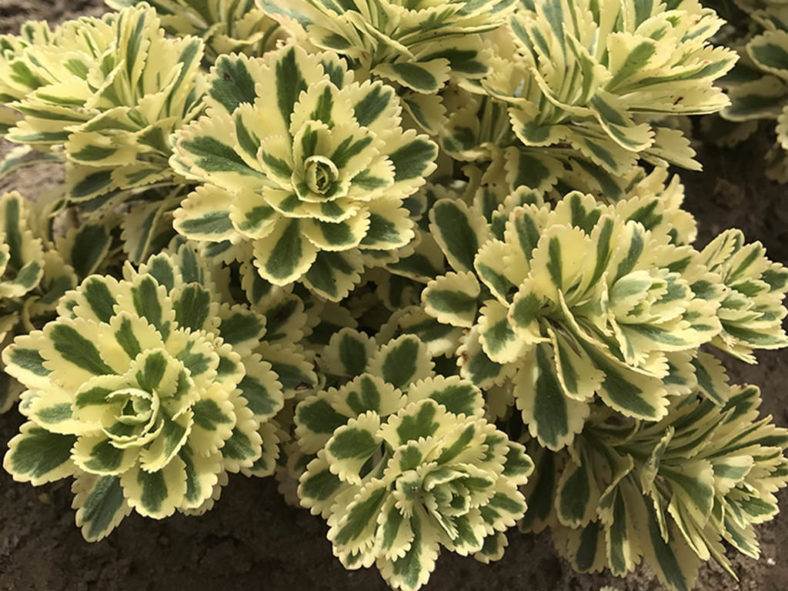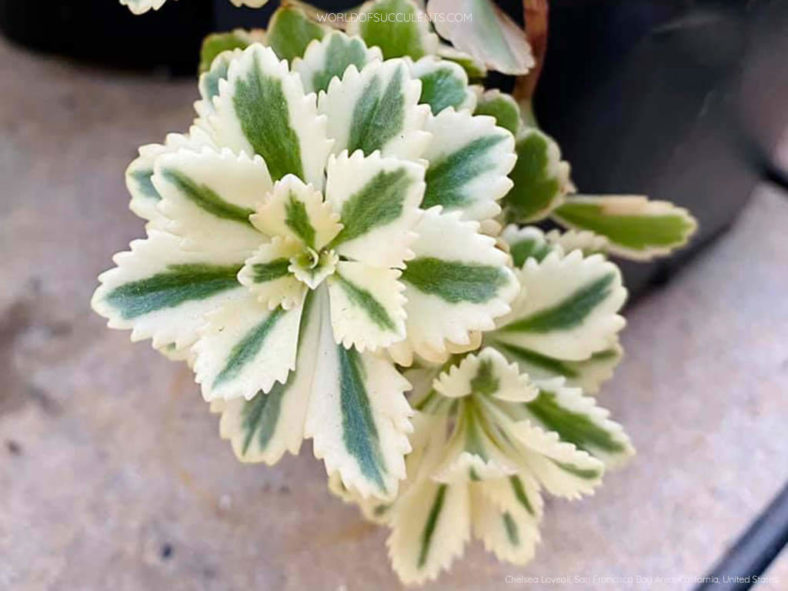Scientific Name
Phedimus takesimensis 'Atlantis'
Accepted Scientific Name
Phedimus takesimense 'Nonsitnal'
Synonym(s)
Phedimus kamtschaticus 'Atlantis', Phedimus kamtschaticus 'Nonsitnal', Phedimus kamtschaticus 'Nonsitnal' Atlantis™, Phedimus takesimensis 'Atlantis', Phedimus takesimensis 'Nonsitnal' Atlantis™, Sedum takesimense 'Atlantis', Sedum takesimense 'Nonsitnal', Sedum takesimense 'Nonsitnal' Atlantis™
Scientific Classification
Family: Crassulaceae
Subfamily: Sempervivoideae
Tribe: Umbiliceae
Genus: Phedimus
Origin
This succulent was discovered in 2013 as a naturally occurring bud mutation by Norberto Miguel Roma, the Inventor at Hortech Nursery in Nunica, Michigan, United States. The mutation was found as a single bud mutation of Phedimus takesimensis 'Gold Carpet' growing in a container block of 500 plants. Patented (PP27454) in 2015 as Phedimus takesimensis 'Nonsitnal', this cultivar of Phedimus takesimensis is usually sold under the trade name "Atlantis."
Description
Phedimus takesimensis 'Atlantis', formerly known as Sedum takesimense 'Atlantis', is a striking succulent that forms ground-covering rosettes of attractively variegated leaves with scalloped margins. It can grow up to 4 inches (30 cm) tall and spread 18 inches (45 cm). The stems are basal, non-branching, and arise from a crown. The leaves are spatulate with green centers and wide, bright creamy-yellow margins. They can reach up to 2 inches (5 cm) in length and 0.9 inches (2.2 cm) in width. As temperatures drop in fall, the margins of the leaves become tinged with pink blush tones.
The yellow flowers are star-shaped and appear in clusters held just above the foliage in summer.

How to Grow and Care for Phedimus takesimensis 'Atlantis'
Light: This light-loving plant will tolerate partial shade, but it prefers full sun and grows best in warmer environments. Plant P. takesimensis 'Atlantis' in an area of your garden that gets at least 6 hours of sunlight a day.
Soil: This succulent thrives in any well-drained soil. Good drainage is critical for preventing root rot or fungal diseases.
Temperature: P. takesimensis 'Atlantis' tolerates frost and can stay outdoors when the temperature drops below freezing. It can withstand temperatures as low as -20 (-28.9 ). USDA Plant Hardiness Zones 5a to 9b, -20 to 30 °F (-28.9 to -1.1 °C).
Watering: The best way to water your P. takesimensis 'Atlantis' is to use the "soak and dry" method. Get the soil completely wet, and then wait until the soil is dry before watering again.
Fertilizing: Feed with low-balanced fertilizer to keep your plant happy and healthy. Use a diluted dose of half the strength recommended on the package.
Repotting: Repot your plant when it outgrows its current pot by moving it out to a larger container to hold the plant better. Spring is the best time to repot P. takesimensis 'Atlantis'. Make sure the soil is dry before you begin the repotting process.
Propagation: Like all members of the genus Phedimus, this succulent can be grown from seeds, division, or stem cuttings. Dividing your P. takesimensis 'Atlantis' is the best method to propagate because it is easy and usually very successful. Divide in spring when new shoots are seen. P. takesimensis 'Atlantis' is also easily propagated from cuttings. Sow seeds in spring in well-drained soil in a sunny position.
Learn more at How to Grow and Care for Phedimus.
Toxicity of Phedimus takesimensis 'Atlantis'
P. takesimensis 'Atlantis' can be mildly toxic to humans and animals.
Links
- Back to genus Phedimus
- Succupedia: Browse succulents by Scientific Name, Common Name, Genus, Family, USDA Hardiness Zone, Origin, or cacti by Genus
Photo Gallery
Click on a photo to see a larger version.


